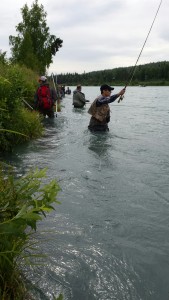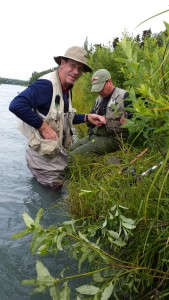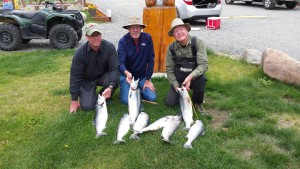Kenai River Sockeye Research
Dr. Jon Boyum, MD and Honorary Homey, invited his dad, Homey Bill Boyum, and me to join him in Alaska for a research project involving sockeye salmon on the Kenai River. I thought we were going to count the sockeye salmon as they went up the Kenai, but I wasn’t sure – when the word “salmon” was dropped into a sentence, I lost track of much of the rest that was said.
Anyhow, early last Friday afternoon, we convened at Anchorage International Airport. Jon and Bill flew north from Spokane, where Jon practices thoracic surgery, and I arrived from Paradise, where no one is quite sure what I do. In moments, we had piled into Dr. Jon’s rental car and pointed it south toward the town of Soldotna on the Kenai Peninsula. I quickly realized that, while fish counts would be critical to our success, we had actually convened for a few days of salmon fishing during the late sockeye run.
This was not Dr. Jon’s first rodeo on the Kenai, and he briefed us on what to expect as we drove around Cook Inlet and down into the forest, mountains and streams of the peninsula.
As it happens, the Kenai River is the most heavily-fished river in Alaska, for several species of salmon. Over the past few years, an average of 275,000 angler-days of participation have been recorded. (An angler-day is one person fishing for any part of one day.) While Jon knew of those fishing holes less trampled, he warned us to expect “combat fishing” for much of our coming adventure. In truth, there was no way he could have prepared us for the crowds, but he did his best. Still, when the fish are running, there are more than enough for everyone.
What we didn’t know at that point was that the Feds had approved a third day per week of gill-netting across the mouth of the Kenai. There is much muttering about how it is affecting the number of fish in the river on the following day – and, thus, the fishing. (Given the importance of all that tourist fishing business to the State of Alaska, one wonders what the !@&? the Feds were thinking. But that is another day’s contemplation.) It remains to be seen for this year, but Kenai River salmon suffer random off years just as do most other rivers. Time will tell.
During a typical year over the last decade, somewhere around 1.5 million sockeye enter the Kenai during the month of July, and average daily counts for the couple weeks centered on the dates we were on the river ranged between 30,000 and 220,000 fish. Daily limits of fish ranged from three to six per angler. At this point in time, we would each be allowed three sockeye.
We checked into our cabin at the Red Fish Lodge, were welcomed by Gramma Marcia on behalf of Steve and Lea Stuber. Once everything was in the cabin, Jon walked us to the river for “Technique Class,” and a reminder to release foul-hooked fish. We caught on, but no fish.
 By 6 p.m. we were down river a few miles, nestled into a line of 40+ of our new best friends. To find open spots, we waded close to shore in fast water to our waists and above, navigating any number of large slippery rocks. We each had a 15-20 foot stretch of river to fish – we would flip the lure out 10 to 20 feet and bounce it along the bottom hoping for a curious or suicidal sockeye. Over the next three hours, Jon Thinks-Like-A-Sockeye caught two nice five- to eight-pound fish. Bill and I flunked our first test, and I tested my ability to recover from a wader-filling fall into the Kenai. 18,000 fish had entered the river on Thursday – not many were catching fish.
By 6 p.m. we were down river a few miles, nestled into a line of 40+ of our new best friends. To find open spots, we waded close to shore in fast water to our waists and above, navigating any number of large slippery rocks. We each had a 15-20 foot stretch of river to fish – we would flip the lure out 10 to 20 feet and bounce it along the bottom hoping for a curious or suicidal sockeye. Over the next three hours, Jon Thinks-Like-A-Sockeye caught two nice five- to eight-pound fish. Bill and I flunked our first test, and I tested my ability to recover from a wader-filling fall into the Kenai. 18,000 fish had entered the river on Thursday – not many were catching fish.
Friday’s count was 17,000 salmon into the Kenai. Saturday, Bill and I and a good many fishers around us were again skunked in the midst of our eight hours of combat fishing, while Jon caught his three. I fell into the river twice, as I gained my river legs, and Homey Bill – what a pal for not wanting me to feel like such a klutz – slipped in as well.
Sunday early morning, we headed upriver and hiked to a beautiful reach that we had to ourselves – for an hour or so. Not enough fish that far upriver yet, but we had great fishing even without them. We headed downriver to another combat zone. There, Jon caught his three, I caught two trout and two salmon and Bill got skunked. I stayed dry in the river while Bill and Jon demonstrated their support for me by each slipping into the water. The previous day’s count was 20,000.
we had to ourselves – for an hour or so. Not enough fish that far upriver yet, but we had great fishing even without them. We headed downriver to another combat zone. There, Jon caught his three, I caught two trout and two salmon and Bill got skunked. I stayed dry in the river while Bill and Jon demonstrated their support for me by each slipping into the water. The previous day’s count was 20,000.
49,000 fish entered the Kenai Sunday, and Monday we fished two combat reaches. At one, we waded past 76 fishers to find our spots, and there were at least that many lined up on the opposite shore. With more fish in the river, everyone was catching. Bill hooked five and kept two, I lost three and kept one, and Dr. Jon hooked 10 and kept three.
 Tuesday, after another 54,000 fish made it to the river, we waded past 85 fishers to find our spots. There, it was Jon three, Jim three and Bill two. That evening we dropped Bill at the Kenai Airport for a flight to his annual family reunion in South Dakota.
Tuesday, after another 54,000 fish made it to the river, we waded past 85 fishers to find our spots. There, it was Jon three, Jim three and Bill two. That evening we dropped Bill at the Kenai Airport for a flight to his annual family reunion in South Dakota.
Wednesday morning at 4, Jon and I headed to the river for a few more hours of fishing before he caught up with the family reunion and I flew back to Paradise. Tuesday’s count had been a bit over 32,000. Jon caught one. We headed for Anchorage.
I would guess that, on any of the days we were fishing, there were well over 1,200 fishers on the river. We caught sockeye up to 10 pounds. We fished alongside laborers, heavy equipment operators, engineers and airline pilots. We were shoulder to shoulder with folks of a dozen languages and most every color and ethnic group on the planet. We talked with men and women from three countries (four if you count Minnesota) and a dozen states. We experienced great kindness and very bad behavior – people are people no matter where you go, I suppose. The fishing was a bit off normal, but we fished a great river Bill and I have long wanted to fish.
We had a great adventure.







